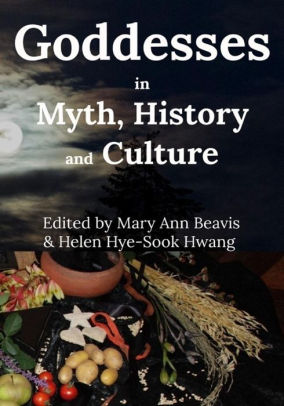When I was first researching Goddesses in the late 1980s, I would have been ecstatic to have had access to this textbook. It does what few other such books do: it provides key selections in translation from religious and mythical material pertaining to the goddess/woman being studied. Thus, students can dip into the Goddesses referenced in the cosmologies of Hinduism and Buddhism, the Babylonian mythos, the Hebrew and Christian Bibles, the Qur’an, and the Ramayana. Contributors were selected based on scholastic qualifications in their respective areas of study, and come from all over the world. Moreover, it places current Goddess worship within a framework and scholastic context that stretches back into the earliest known civilizations.
Chapters are grouped into five sections: Pre-patriarchal Goddesses, Goddesses in Ancient Religions, Goddesses in Indigenous Traditions, Goddesses in World Religious Traditions, and New Goddess Spiritualities. The topics may overlap with the contents of other anthologies but this textbook contains some distinctive contributions.
This is a big, meaty, book, as appropriate for a textbook. All chapters are formatted so that full bibliographical information can be found in the copious footnotes. There are so many references that it they are a separate PDF, download available in a page entitled Goddesses in Myth, History and Culture under the menu of Textbooks in http://www.magobooks.com).
The weakest part of Goddesses in Myth, History, and Culture comes about when the contributors proffer evidence of worldwide prehistoric matriarchies. Certainly when I was researching goddesses back in the day I heard the theory of the existence of a prehistoric matriarchy in virtually every book I read that came out of the feminist spirituality movement. Those books posited that matriarchy was no peculiarity, but a worldwide phenomenon that stretched back through prehistory to the very origins of the human race. These "matriarchies"—often called by other names—were not crude reversals of patriarchal power, but models of peace, plenty, harmony with nature, and, significantly, sex egalitarianism. It allowed me -- and many like me -- to imagine a reality in which biological sex did not immediately make the idea of their leadership, creativity, or autonomy either ridiculous or suspect.
Scholars have since declared, rightly, that there is no evidence that earlier civilizations were actually ruled by women. This is perfectly true, for there are no written records extant for these periods (which constitute a length of history many times greater than the whole era of patriarchy) and it is impossible to be certain what their social institutions were. It is absolutely true that there is evidence that Goddesses were worshiped, that there were female rulers, and that women held positions of power and authority to varying degrees in various societies. Moreover, there are matrilineal societies (particularly in India as well as the Hopi and Iroquoi in America and the Mosuo in China) that stretch back into the dawn of time. All of that a matriarchy does not make.
When all is said and done the evidence available to us regarding gender relations in prehistory is sketchy and ambiguous, and always subject to individual bias (cultural, religious, and/or political). Bottom line: the evidence we do have from prehistory cannot support the weight laid upon it by the matriarchal thesis. Prehistory could have been matriarchal, but it probably wasn't, and nothing offered up in support of the matriarchal thesis is especially persuasive.
The textbook comes into its true power when it moves into documented Goddesses and their role within societies. There is a wealth of new information catalogued. Specifically two chapters each on Korean/East Asian Goddesses and Norse Goddesses, a chapter on the Goddess Gemu in the matrifocal Mosuo culture of southwest China; chapters on the Goddess in the monotheistic religions of Judaism, Christianity, and Islam, and a chapter on Goddess, Science and Paganism. I found the chapter on the Korean/East Asian Goddess particularly interesting as the source materials are so rarely found in English.
We have so few well-researched and sourced textbooks that focus on the Goddess in cultures, especially ones that feature only women authors that Goddesses in Myth, History, and Culture becomes instantly important. For that alone I would recommend it; on its own it is a rich and deep textbook.
~review by Lisa Mc Sherry
Edited by Mary Ann Beavis and Helen Hye-Sook Hwang
Mago Books, 2018
434 pages
$40 b/w, $80 color, $29.99 pdf through https://www.magobooks.com/mago-bookstore
Goddesses in Myth, History and Culture

©
2010 - 2025
Facing North
